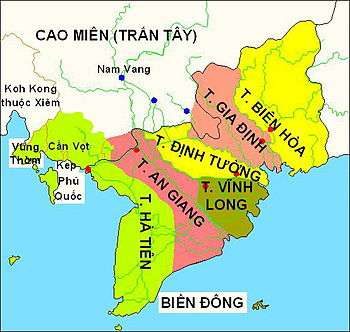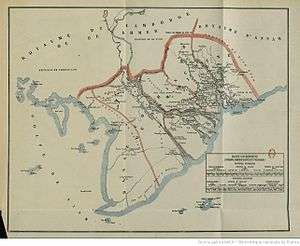Six Provinces of Southern Vietnam

.jpg)

The Six Provinces of Southern Vietnam (Vietnamese: Nam Kỳ Lục tỉnh, 南圻六省 or just Lục tỉnh, 六省) is the historical name for a particular region of Southern Vietnam which is referred to in French as Basse-Cochinchine. (Lower Cochinchina).[1] The region was politically defined and established after the independence of the Nguyễn Dynasty, and lasted from 1832, when Emperor Minh Mạng introduced administrative reforms, to 1867, which culminated in the eight-year French campaign to conquer the Six Provinces.
The six provinces, which in 1832 Emperor Minh Mạng divided Southern Vietnam into, are:
- Phiên An, later changed name to Gia Định (provincial capital city: Sài Gòn),
- Biên Hòa (provincial capital: Biên Hòa),
- Định Tường (provincial capital: Mỹ Tho)
- Vĩnh Long (provincial capital: Vĩnh Long),
- An Giang (provincial capital: Châu Đốc),
- Hà Tiên (provincial capital: Hà Tiên).
These provinces are often subdivided into two groups: the three eastern provinces of Gia Định, Định Tường, and Biên Hòa; and the three western provinces of Vĩnh Long, An Giang, and Hà Tiên.
History
.jpg)
The Mekong Delta region (the location of the Six Provinces) was gradually annexed by Vietnam from the Khmer Empire starting in the mid 17th century to the early 19th century, through their Nam tiến territorial expansion campaign. In 1832, Emperor Minh Mạng divided Southern Vietnam into the six provinces Nam Kỳ Lục tỉnh.
According to the Đại Nam nhất thống chí (Nguyễn Dynasty national atlas) of the Quốc sử quán (official Nguyễn-era compilation of Vietnamese history, geography and people from 1821-1945), in 1698 the lord Nguyễn Phúc Chu established the prefecture (phủ) of Gia Định. In 1802, emperor Gia Long turned Gia Định prefecture into a township, and in 1808, he renamed Gia Định prefecture into a governorate containing the 5 townships of Phiên An, Biên Hòa (or Đồng Nai), Định Tường, Vĩnh Thanh (or Vĩnh Long), and Hà Tiên. In 1832, emperor Minh Mạng renamed Phiên An Citadel into Gia Định Citadel, and the 5 townships were turned into the 6 provinces of Phiên An, Biên Hòa, Định Tường, Vĩnh Long, Hà Tiên, and the newly established An Giang. Thus, the Six Provinces was created in 1832; and in 1834 the Six Provinces were collectively called Nam Kỳ ("Southern Region", which would eventually be known in the West as Cochinchina). Phiên An Province was renamed to Gia Định Province in 1835.[2]
After the French colonial invaders, led by vice-admiral Rigault de Genouilly attacked and captured the three eastern provinces of Gia Định, Định Tường, and Biên Hòa in 1862, and invaded the remaining western provinces of Vĩnh Long, An Giang, Hà Tiên in 1867, the French Empire abolished the administrative divisions created by the Nguyễn Dynasty. At first, the French used départements instead of prefectures, and arrondissements in place of districts (huyện).[3] By 1868, the former Nam Kỳ Lục tỉnh had over 20 arrondissements (districts). Cochinchina was ruled by a French government-appointed governor in Saigon, and each county had a Secrétaire d’Arrondissement (en: "County Secretary", vi: "thư ký địa hạt" or "bang biện"). Bạc Liêu county was created in 1882. On 16 January 1899, the counties were changed into provinces per a French government decree, each with a provincial premier (fr: "chef de la province", vi: "chủ tỉnh") who is head of provincial government.
French division into 21 smaller provinces, discontinuation of the Six Provinces
The French government divided the original Six Provinces into 21 smaller ones. Following the 1899 decrees, starting 01/01/1900 Nam Kỳ would be divided into the following 21 provinces:
- Gia Định Province was divided into the 5 provinces of: Gia Định, Chợ Lớn, Tân An, Tây Ninh, and Gò Công.
- Biên Hòa Province was divided into the 4 provinces of: Biên Hòa, Bà Rịa, Thủ Dầu Một, and Cap Saint-Jacques (later Vũng Tàu Province). Cap Saint Jacques was created on 30/04/1929 and dissolved 01/01/1935; in 1947 the province was re-established under the name Vũng Tàu until 1952 when it was dissolved again.
- Định Tường Province became Mỹ Tho Province.
- Vĩnh Long Province was divided into the 3 provinces of: Vĩnh Long, Bến Tre, and Trà Vinh.
- An Giang Province was divided into the 5 provinces of: Châu Đốc, Long Xuyên, Sa Đéc, Sóc Trăng, and Cần Thơ.
- Hà Tiên Province was divided into the 3 provinces of: Hà Tiên, Rạch Giá, Bạc Liêu.
- On 11/05/1944 Tân Bình Province was created, carved out of Gia Định Province.
The reason why Southern Vietnam was divided into 21 provinces[4] was because the French Empire intended to erase the name "Lục tỉnh" from the hearts and minds of the Vietnamese people and language, and cut any feelings of attachment and Vietnamese nationalism with this region, in attempts to avert potential local revolution or rebellion that may arise. In 1908 on the newspaper Lục Tỉnh Tân Văn ("Six Provinces News"), lead editor by Gilbert Trần Chánh Chiếu, still commonly used the names "Lục Tỉnh" and "Lục Châu". Along with the French Empire calling Southern Vietnam (vi: Nam Kỳ) as Cochinchine, they called Northern Vietnam (vi: Bắc Kỳ) as Tonkin, Central Vietnam (vi: Trung Kỳ) as Annam. "Cochinchina" is the name used by Westerners.[5]
Administrative divisions
| Biên Hòa Province | Gia Định Province | Định Tường Province | Vĩnh Long Province | An Giang Province | Hà Tiên Province |
|---|---|---|---|---|---|
| Phước Long (Dô Sa) Prefecture
Counties:
|
Tân Bình (Sài Gòn) Prefecture
Counties:
|
Kiến An (Cai Tài Market) Prefecture
Counties:
|
Định Viễn (Vĩnh Long) Prefecture
Counties:
|
Tuy Biên Prefecture
Counties:
(Hà Âm county, which is north of Vĩnh Tế Canal, is now part of Cambodia). |
An Biên Prefecture
Counties:
|
| Phước Tuy (Mô Xoài) Prefecture
Counties:
|
Tân An Prefecture (later split into):
Counties:
|
Kiến Tường (Cao Lãnh) Prefecture
Counties:
|
Hoằng Trị (Bến Tre) Prefecture
Counties:
|
Tân Thành Prefecture
Counties:
|
Quảng Biên Prefecture (which formerly
included today's Cambodian provinces of Kampot (vi: Cần Vột), Kep, and Sihanoukville (Kampong Som) (vi: Vũng Thơm)). Counties:
|
| - | Tây Ninh Prefecture (which formerly
included Svay Rieng Province in Cambodia today) Counties:
|
- | Lạc Hóa (Chà Vinh) Prefecture
Counties: |
Ba Xuyên Prefecture
Counties:
|
- |
Sources for entire table:[1][6]
See also
- Cochinchina
- French Indochina
- Provinces of Vietnam
- Map of South Vietnam (Republic of Vietnam) and its provinces
- Map of Vietnam and its provinces
- Đại Nam nhất thống chí
- Gilbert Trần Chánh Chiếu
- Siamese-Vietnamese War (1841-1845)
- Dark ages of Cambodia
References
- 1 2 Trương, Jean Baptiste Pétrus Vĩnh Ký. "Petit cours de géographie de la Basse-Cochinchine (Small Course on Lower Cochinchina Geography)". Bibliothèque nationale de France (National Library of France). Retrieved 4 January 2014.
- ↑ Đại Nam Nhất Thống Chí. Volume 5. Phạm Trọng Điềm dịch. Đào Duy Anh hiệu đính (Nxb Thuận Hóa, 1992, trang 122, 133, 200, 201). Tuy nhiên, sử Nguyễn là Quốc triều sử toát yếu (tr. 205) và Nguyễn Đình Đầu ("Địa lý lịch sử Thành phố Hồ Chí Minh", trong Đại chí văn hóa Thành phố Hồ Chí Minh (tập 1). Nxb TP. HCM, 1987, tr. 209) đều cho rằng: "Tháng 5 (âm lịch) năm Quý Tỵ (1833), Lê Văn Khôi khởi binh chiếm thành Phiên An. Tháng 8 (âm lịch) năm đó, vua Minh Mạng cho đổi tỉnh Phiên An thành tỉnh Gia Định".
- ↑ Bulletin de la Société des Études Indochinoises (Nouvelle série, Tome XX). Sài Gòn: 1945, p. 16.
- ↑ Sau này, ngày 11 tháng 5 năm 1944, Pháp lập tỉnh thứ hai mươi hai là Tân Bình, gồm một phần tỉnh Gia Định và Chợ Lớn nhập lại.
- ↑ Để tham khảo, sau đây là cách giải thích của Nguyễn Đình Đầu (“Thay lời giới thiệu”, in trong: Pierre Pegneaux de Béhaine Bá Đa Lộc Bỉ Nhu, Tự Vị An Nam La Tinh. Hồng Nhuệ Nguyễn Khắc Xuyên dịch và giới thiệu. Nxb Trẻ, 1999, tr: 5-6.): “Chúng ta có thể tóm tắt: địa danh COCINCINA chia ra làm hai phần COCIN và CINA. Cocin nguyên trước là Co Ci, do phiên âm hai tiếng Giao Chỉ mà thành (vì thế Tự Vị An Nam La Tinh mới dịch Người Giao Chỉ là Cocincinenses). Còn Cina thì bởi âm Sin hay Ts’inn và người mình đọc là Tần mà ra. Bên Ấn Độ có một thành phố tên COCHIN, sợ lẫn với Cochi hay Cochin, nên phải ghi rõ “Giao Chỉ (gần) Tần” và chữ Latinh ghi thành COCINCINA (mà người Nhật hay Trung Hoa ghi ra Giao Chỉ Chi Na). Trên các bản đồ Tây phương vẽ Đông Nam Á, từ trước cho tới thế kỷ 17, đều ghi trên địa phận nước ta tên COCINCINA, CAUCHINCHINA, COCHINCHINA, COCHIN-CHINE hoặc dạng tự nào đại khái như thế để nói lên đó là xứ GIAO CHỈ GẦN NƯỚC TẦN. Do đó, ta có thể đoán địa danh ấy đã xuất hiện từ khi nước ta gọi là quận Giao Chỉ bị nhà Tần đô hộ. “Từ đầu thế kỷ 17, hai họ Trịnh-Nguyễn tranh giành quyền lực, phân chia nước ta thành hai vùng cai trị Đàng Trong và Đàng Ngoài, lấy sông Gianh làm ranh giới phân ly. Trên bản đồ cũng như trong văn kiện, người Tây phương gọi Đàng Ngoài là TUNQUYN (hoặc nhiều dạng tương tự như TUMQUYN, TUNKIN, TONGKING, TONKIN...) tức lấy tên thủ đô ĐÔNG KINH để gọi bao quát cả Đàng Ngoài. Còn Đàng Trong thì họ vẫn dùng tên cũ COCINCINA mà gọi. Đàng Trong dưới thời Đắc Lộ (Từ Điển Việt-Bồ-La) rộng từ sông Gianh tới núi Đá Bia ở dinh Phú Yên. Trên một thế kỷ sau – thời của Bỉ Nhu với Tự Vị An Nam La Tinh –, địa danh COCINCINA lại chỉ thêm phần đất phương nam rất rộng lớn. Phần Nam Bộ xưa được mệnh danh là xứ Đồng Nai. Năm 1698, xứ Đồng Nai được thiết lập phủ huyện. Phủ GIA ĐỊNH tồn tại suốt từ đó đến năm 1800 và bao gồm toàn thể đất Nam Bộ. (...) Lại từ sau 1885, khi Pháp đã chiếm hết Việt Nam, Pháp chia cắt nước ta thành ba khúc và mệnh danh: TONKIN là BẮC KỲ ANNAM là TRUNG KỲ COCHINCHINE là NAM KỲ “Cả ba địa danh Đông Kinh, An Nam, Giao Chỉ (gần) Tần đã bị Tây ngữ hóa và đặt tên cho những phần đất chẳng ăn nhằm gì với ý nghĩa của nguyên ngữ.”
- ↑ Đại Nam nhất thống chí, quyển XXXI, tỉnh Gia Định, trang 204.
External links
- Official website on the Six Provinces, used by archaeologists, historians and researchers.
- Notes on the Six Provinces written by Professor Lâm Văn Bé.
- Extensive Geographical and Brief Historical Information on the Six Provinces, from the French National Library (French)